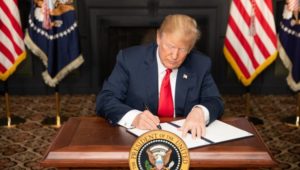One Year Into Trump’s Iran Strategy: Where Do Things Stand?
One Year Into Trump’s Iran Strategy: Where Do Things Stand?
In May 2018, President Trump withdrew the United States from the Iran nuclear deal—also known as the Joint Comprehensive Plan of Action (JCPOA).

Shortly thereafter, Secretary of State Mike Pompeo announced a new U.S. strategy toward Iran: the “maximum pressure” campaign. Going far beyond the scope of the JCPOA, Pompeo articulated 12 demands, including that Iran end its nuclear weapons and advanced ballistic missile programs, release hostages, stop supporting terrorism and put a stop to its destabilizing activities across the Middle East.
A year later, it is still unclear whether maximum pressure should be understood as a means of getting Iran back to the negotiating table. During a recent news conference in Japan, Trump indicated a willingness to return to negotiations, saying, “I really believe that Iran would like to make a deal.” Meanwhile, Pompeo routinely states that the ultimate goal is to get Iran to behave “like a normal nation,” making the 12 demands seem more like an end in and of themselves. Speaking at a press conference in Switzerland on June 2, Pompeo said the U.S. was open to talks even though “the American effort to fundamentally reverse the malign activity of this Islamic Republic, this revolutionary force, is going to continue.” As tensions between the U.S. and Iran continue to mount, a looming question remains: How far is the administration willing to go to make Iran change its behavior?
This post examines U.S. policy toward Iran over the past year. We first focus on the four categories of actions the U.S. has pursued against Iran. Recognizing that it is likely too soon to assess Pompeo’s 12 demands in full, we then examine the administration’s relative progress toward achieving them to date.
Four Types of Pressure
The Trump administration has mainly used four types of pressure to put its maximum pressure campaign into action: economic sanctions; designating the Iranian Revolutionary Guard Corps (IRGC) as a foreign terrorist organization (FTO); diplomatic efforts; and, more recently, the deployment of military assets. While none of the tools is novel, the Trump administration is the first to designate an agency of a foreign government as an FTO. Likewise, its reliance on sanctions far exceeds the pre-JCPOA levels, and—perhaps more notably—it has largely acted without European coordination or support.
Iran Briefing | News Press Focus on Human Rights Violation by IRGC, Iran Human Rights

